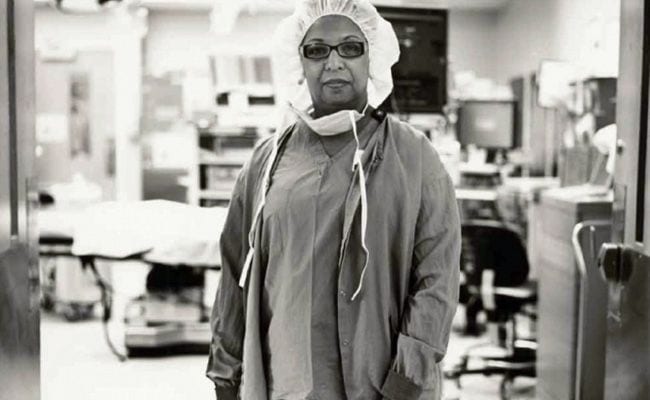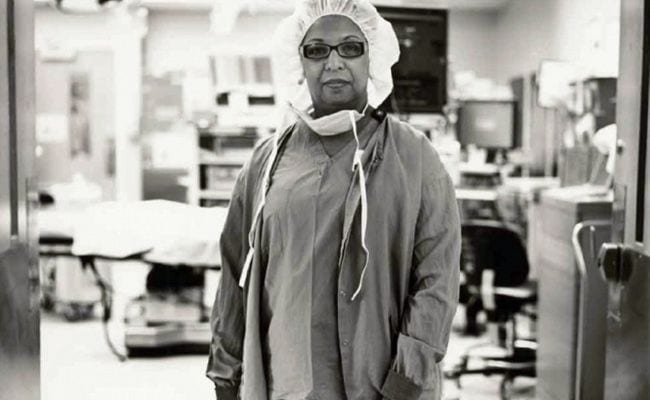
“Angola saved me.” It’s not the first thing you’d expect to hear from an inmate at Louisiana’s notorious Angola State Penitentiary. “I lived a treacherous life on the street,” continues Lafayette Ballard. “I didn’t care about life itself, I played with death, running with the wrong people.” No longer running, Lafayette now works as a hospice volunteer alongside nurse Tonia Faust.
Lafayette’s changed view of life — himself, his fellow inmates, and death too — shapes just a brief moment in The American Nurse, but that moment has to do with everything else you see. Photographer Carolyn Jones introduces her documentary as an homage to nurses, a project initiated as a book of photographs and inspired by her own experience with her chemotherapy nurse, “the one who got me through it.”
The five nurses who appear in The American Nurse all offer similar stories, but each does so very differently. While you see low, wide shots of barbed wire and tattooed arms outstretched from tiny windows in cell doors, Faust begins to describe her choice. “A lot of people ask me how I can take care of people who have committed such horrific crimes,” she says. “You put yourself in their spot, what they went through: it just gives you a completely different perspective.” Faust’s mother notes that she had her own doubts when her daughter told her she had taken a job nursing men who had committed “horrific crimes,” but then she figured that if anything happened, Tonia, like her mother had grown up around guns and was a “good shot.” Seated closely together at home, the women’s easy-seeming intimacy and trust suggests one reason for Faust’s compassion for Lafayette and also for her patients. One old man, tall, pale, and bent, testifies, “She’s helped me helped me tremendously, especially with the relationship with my daughter,” a daughter who hadn’t spoken to him in the 20 plus years since he shot and killed his wife. “I know they’re in here for something,” Faust says, “They’re here doing their time and I’m not here to judge them, I’m just there to take care of them.”
Jason Short, a home health nurse in Appalachia, has found in nursing a way through judging himself. As he puts it — and as the film reveals in photos of a longhaired kid, mugging like a monster with a backwards baseball cap. Bringing the camera crew along on a visit to his childhood home, now abandoned, Short remembers, “18 was a really bad year for me.” For all his not caring and bad behavior, he was brought up short by a motorcycle accident that nearly killed him and left him feeling “helpless” for over a year. Even now, seated against a plastic-wood-paneled wall on a linoleum floor, he pauses and chokes up, asking the camera to stop filming. Following his recovery, this former “hyper child” says he discovered a similarity between fixing trucks and “gross anatomy,” as well as a new goal. In another sort of film, Short’s visit to his own father’s gravesite might have seemed cloying, but given this context, a series of long shots showing how far he travels to visit his patients, through mud and flooding and over mountain roads, you’re inclined to see his journeys in another frame.
For Short and his fellow nurses, the film suggests, this frame has to do with personal backgrounds, limits overcome and hopes achieved, but also with other people. As much as Jones’ subjects might reveal about themselves, or as much as you see of their daily business, the film’s focus takes up that of the nurses’, which is to say, their mostly unnamed patients and their worried relatives. Standing in a tiny doorway, Short suggests to one caretaker that the patient’s rapid heart rate may have been caused by the obstruction in her ostomy bag, which he’s just cleared gently with his gloved finger, but a sign of something else, and they’ll need to be attentive to what happens in the coming days. Cut to the next shot, from inside Short’s SUV, as the relative smiles, taking the new appliance supplies he hands her through the window, assured as he’s just told her he’ll come back whenever she calls.
The film’s connections between scenes — within single storylines and also across the experiences of the various nurses — construct an emotional and moral throughline, beyond particular place or crisis. Where the majority of cases for Naomi Cross, who works as a birthing nurse at Johns Hopkins, don’t involve emergencies, when such moments arise, she feels especially prepared to serve as a bereavement counselor. “It’s hard for some people to get their mind around miscarriage,” she says, “How can death happen before birth?” As Cross tells her own harrowing story and her struggle with guilt, she also points to the support she felt from nurses. Her husband describes the necessity for this kind of emotional network: “People that work in this profession,” he observes, “They can’t talk about what happened in their day. They need somebody to vent to.”
The film provides another means to “talk about what happened in their day,” most effectively without any talking at all. The interviews with subjects provide some remarkable details of individual lives, descriptions of determining events and motivations. Still, many of The American Nurse‘s most affecting moments are observational, the camera looking on from a distance as Sister Stephen, Director of Nursing at the Villa Loretto Nursing Home in rural Wisconsin, leads a small herd of goats to visit her elderly patients, backed by bright green grass and blue sky, or when Brian McMillion, a military nurse in San Diego, is on hand to greet soldiers on gurneys returning from theater.
He articulates the terrible irony of what he does, which is tend to people who have been sent on missions to hurt other people (“We aim them, we point that at the enemy, and find out they’re not invincible”). With his own background as a soldier, he understands living with trauma, a subject he addresses head on and also talks around: he’s had trouble with relationships, and chooses to focus on his work, “living out of a suitcase” for the past two years; yet when you see him with a veteran who’s also an amputee, and the man’s family gathered in a dynamic domestic scene, the camera close and mobile, the veteran’s daughter pitching in and out of frame, you see as well that understanding trauma is central to all nursing.

